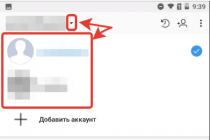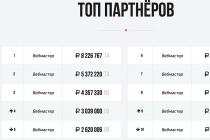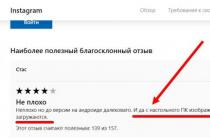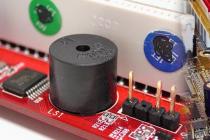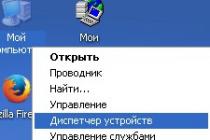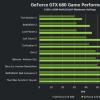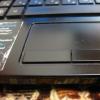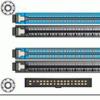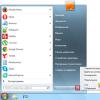Knowing what ALT codes are and how to use them, you can quickly enter many characters from the keyboard, for which there are no separate keys initially.
We often see them on the pages of websites. Especially a lot of them in user statuses social networks. In addition, they are also found in various printed materials: magazines, newspapers, books ... Almost everywhere where there is a place for any typography, you can find alt codes.
It all started with a dash
I was prompted to think about this article by the situation with the correction at work in one of the many documents of hyphens to a normal em dash. To enter the latter, I used the keyboard shortcut CTRL + - on the numeric keypad in Word. However, knowing a little HTML and remembering that it has two types of dashes (long - - and short - -), I wondered if it was possible to enter its different types from the keyboard?
Starting to look in this direction, I came across the 97th paragraph of "ru.Kovodstva" from the famous domestic designer Artemy Lebedev. It says that you need to distinguish between 4 dash characters: a hyphen, a minus, an en dash and an em dash.
But on the keyboard, we only have a hyphen (and not quite a hyphen, as it turns out), so the rest of the characters need to be added in a special way: using special alt codes. To enter them, you need to hold down the ALT key and press certain combinations of numbers on the side numeric keypad with the active NumLock switch. On laptops without additional number keys, their functions are usually performed by the buttons on the right side of the keyboard while holding down the Fn modifier key. All this is indicated in the form: ALT + numeric code:
But that, it turns out, is not all! Digging deeper, I found another very curious one, where the author says that there are at least 9 (!) Different dashes in total, which can be not only hyphens and dashes! So, for example, I found out that on the keyboard, the button that many people call a minus or a hyphen actually introduces a separate character altogether - hyphen-minus, which is slightly longer than a hyphen, but shorter than a minus!
In general, the topic of alt codes and HTML codes turned out to be very interesting and I decided to study the issue more thoroughly...
Where do ALT codes come from?
The story with alt codes began since the time of the operating room MS-DOS systems. There, while holding down the ALT key and entering a certain numeric sequence on the numeric keypad, this sequence was interpreted by the BIOS and output directly as an ASCII character with the corresponding code.
With the advent and spread of Windows, ASCII character tables migrated to various text encodings, retaining partial compatibility, character sets, and the mechanism of ALT codes. To see all the characters available in a particular font and find out their codes, you can use the regular program symbol table(WIN + R - charmap - Enter). By the way, you can also copy the necessary icons from it in visual mode:
There are currently three types of alt codes:
- Ordinary- are entered by holding down the ALT key and dialing numbers from 1 to 255. At the same time, the code 256 (like 0) does not give any character, and after 256 all characters are repeated with a frequency of 256, that is, 1=257=513=769 .. ., 2=258=514=770... etc. In fact, we have an 8-bit character set (28 = 256) defined for the Windows encoding.
- 0-leading- are entered in the same way as usual, but they always use zero as the first digit. 0-leading ALT codes do not match regular ALT codes, but contain partially repeated characters. For example, a paragraph icon in normal codes is inserted using ALT+21, and in 0-leading codes ALT+0167. Like regular ones, they contain 256 characters and repeat in the same way after code 0256, but the character set in them corresponds to the old ASCII set. What is characteristic, when entering in the Russian and English layouts, characters with the same code differ (see tables below).
- hexadecimal or Unicode - usually not available for input under normal conditions. Unicode characters can only be displayed properly on web pages (entered in HTML code according to the "character_code" scheme or using special mnemonics) or in word processors, like Microsoft office Word or OpenOffice Writer. In the latter, they can be entered as ordinary ALT codes, taking into account the transfer of the number system from hexadecimal to 10-decimal. That is, to add, for example, the same paragraph icon that has the code "00A7" in the symbol table, you need to enter the code "0167" while holding down the ALT button. You can quickly convert a hexadecimal number to a 10-decimal system in the standard Windows Calculator by activating "View" - "Programmer", switching the input mode from "Hex" to "Dec":
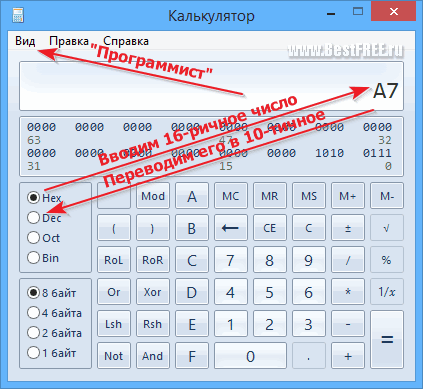
Let's pay a little more attention to hexadecimal codes. Unlike regular ALT codes and 0-leading codes, they can contain up to 65536 characters (216 = 65536). In this case, the first 256 characters coincide with the classic ASCII set and, accordingly, with 0-leading characters, but are not limited to them. In order to distinguish Unicode characters from ordinary ALT codes, they are often written according to the "U + character_code" scheme (we can find such an entry in the Character Table).
In Windows, it is possible to activate the direct input of hexadecimal ALT codes without converting them to a 10-decimal system. To do this, open Registry Editor(WIN + R - regedit - Enter), go to section HKCU\Control Panel\Input Method and add a new one String section(REG_SZ type) named EnableHexNumpad and meaning 1 and then restart your computer:

After the reboot, you will be able to enter U-codes in the same form in which they are written in the Symbol Table. The only caveat is that while entering a number, you will need to not only hold ALT, but also press the "+" button on the numeric keypad before the code itself (if the desired character is not added, "+" must be held together with ALT).
Alt codes tables
A complete list of all characters of the font, as we found out, can be found in the Character Table, and here we will give complete tables regular ALT codes and 0-leading ones.
Table of common alt codes
| Alt code | Symbol | Alt code | Symbol | Alt code | Symbol | Alt code | Symbol | Alt code | Symbol |
| 0 | (empty) | 1 | ☺ | 2 | ☻ | 3 | 4 | ♦ | |
| 5 | ♣ | 6 | ♠ | 7 | 8 | ◘ | 9 | ○ | |
| 10 | ◙ | 11 | ♂ | 12 | ♀ | 13 | ♪ | 14 | ♫ |
| 15 | ☼ | 16 | 17 | ◄ | 18 | ↕ | 19 | ‼ | |
| 20 | ¶ | 21 | § | 22 | ▬ | 23 | ↨ | 24 | |
| 25 | ↓ | 26 | → | 27 | ← | 28 | ∟ | 29 | ↔ |
| 30 | ▲ | 31 | ▼ | 32 | (space) | 33 | ! | 34 | " |
| 35 | # | 36 | $ | 37 | % | 38 | & | 39 | " |
| 40 | ( | 41 | ) | 42 | * | 43 | + | 44 | , |
| 45 | - | 46 | . | 47 | / | 48 | 0 | 49 | 1 |
| 50 | 2 | 51 | 3 | 52 | 4 | 53 | 5 | 54 | 6 |
| 55 | 7 | 56 | 8 | 57 | 9 | 58 | : | 59 | ; |
| 60 | < | 61 | = | 62 | > | 63 | ? | 64 | @ |
| 65 | A | 66 | B | 67 | C | 68 | D | 69 | E |
| 70 | F | 71 | G | 72 | H | 73 | I | 74 | J |
| 75 | K | 76 | L | 77 | M | 78 | N | 79 | O |
| 80 | P | 81 | Q | 82 | R | 83 | S | 84 | T |
| 85 | U | 86 | V | 87 | W | 88 | X | 89 | Y |
| 90 | Z | 91 | [ | 92 | \ | 93 | ] | 94 | ^ |
| 95 | _ | 96 | ` | 97 | a | 98 | b | 99 | c |
| 100 | d | 101 | e | 102 | f | 103 | g | 104 | h |
| 105 | i | 106 | j | 107 | k | 108 | l | 109 | m |
| 110 | n | 111 | o | 112 | p | 113 | q | 114 | r |
| 115 | s | 116 | t | 117 | u | 118 | v | 119 | w |
| 120 | x | 121 | y | 122 | z | 123 | { | 124 | | |
| 125 | } | 126 | ~ | 127 | ⌂ | 128 | A | 129 | B |
| 130 | IN | 131 | G | 132 | D | 133 | E | 134 | AND |
| 135 | W | 136 | AND | 137 | Y | 138 | TO | 139 | L |
| 140 | M | 141 | H | 142 | ABOUT | 143 | P | 144 | R |
| 145 | WITH | 146 | T | 147 | At | 148 | F | 149 | X |
| 150 | C | 151 | H | 152 | W | 153 | SCH | 154 | Kommersant |
| 155 | S | 156 | b | 157 | E | 158 | YU | 159 | I |
| 160 | A | 161 | b | 162 | V | 163 | G | 164 | d |
| 165 | e | 166 | and | 167 | h | 168 | And | 169 | th |
| 170 | To | 171 | l | 172 | m | 173 | n | 174 | O |
| 175 | P | 176 | ░ | 177 | ▒ | 178 | ▓ | 179 | │ |
| 180 | ┤ | 181 | ╡ | 182 | ╢ | 183 | ╖ | 184 | ╕ |
| 185 | ╣ | 186 | ║ | 187 | ╗ | 188 | ╝ | 189 | ╜ |
| 190 | ╛ | 191 | ┐ | 192 | └ | 193 | ┴ | 194 | ┬ |
| 195 | ├ | 196 | ─ | 197 | ┼ | 198 | ╞ | 199 | ╟ |
| 200 | ╚ | 201 | ╔ | 202 | ╩ | 203 | ╦ | 204 | ╠ |
| 205 | ═ | 206 | ╬ | 207 | ╧ | 208 | ╨ | 209 | ╤ |
| 210 | ╥ | 211 | ╙ | 212 | ╘ | 213 | ╒ | 214 | ╓ |
| 215 | ╫ | 216 | ╪ | 217 | ┘ | 218 | ┌ | 219 | █ |
| 220 | ▄ | 221 | ▌ | 222 | ▀ | 223 | ▀ | 224 | R |
| 225 | With | 226 | T | 227 | at | 228 | f | 229 | X |
| 230 | c | 231 | h | 232 | w | 233 | sch | 234 | b |
| 235 | s | 236 | b | 237 | uh | 238 | Yu | 239 | I |
| 240 | Yo | 241 | yo | 242 | Є | 243 | є | 244 | Ї |
| 245 | ї | 246 | Ў | 247 | ў | 248 | ° | 249 | ∙ |
| 250 | · | 251 | √ | 252 | № | 253 | ¤ | 254 | ■ |
| 255 | (space) | 256 | (empty) |
Table of 0-leading alt codes (Russian layout)
| Alt code | Symbol | Alt code | Symbol | Alt code | Symbol | Alt code | Symbol | Alt code | Symbol |
| 00 | null (empty) | 01 | SOH (beginning of "header") | 02 | STX (beginning of "text") | 03 | ETX (end of "text") | 04 | EOT (end of transmission) |
| 05 | ENQ (request confirmation) | 06 | ACK (acknowledge) | 07 | BEL (signal) | 08 | BS (backspace) | 09 | TAB (tab) |
| 010 | LF (line feed) | 011 | VT (vertical tab) | 012 | ff( new page) | 013 | CR (carriage return) | 014 | SO (encoding switch) |
| 015 | SI (revert encoding) | 016 | DLE (data shielding) | 017 | 018 | DC2 (turn on puncher) | 019 | ||
| 020 | DC4 (turn off puncher) | 021 | 022 | SYN (data sync) | 023 | ETB (end of text block) | 024 | CAN (cancel) | |
| 025 | EM (end of media) | 026 | SUB (substitute) | 027 | ESC (escape) | 028 | FS (file separator) | 029 | GS (group separator) |
| 030 | RS (record separator) | 031 | US (unit separator) | 032 | space | 033 | ! | 034 | " |
| 035 | # | 036 | $ | 037 | % | 038 | & | 039 | " |
| 040 | ( | 041 | ) | 042 | * | 043 | + | 044 | , |
| 045 | - | 046 | . | 047 | / | 048 | 0 | 049 | 1 |
| 050 | 2 | 051 | 3 | 052 | 4 | 053 | 5 | 054 | 6 |
| 055 | 7 | 056 | 8 | 057 | 9 | 058 | : | 059 | ; |
| 060 | < | 061 | = | 062 | > | 063 | ? | 064 | @ |
| 065 | A | 066 | B | 067 | C | 068 | D | 069 | E |
| 070 | F | 071 | G | 072 | H | 073 | I | 074 | J |
| 075 | K | 076 | L | 077 | M | 078 | N | 079 | O |
| 080 | P | 081 | Q | 082 | R | 083 | S | 084 | T |
| 085 | U | 086 | V | 087 | W | 088 | X | 089 | Y |
| 090 | Z | 091 | [ | 092 | \ | 093 | ] | 094 | ^ |
| 095 | _ | 096 | ` | 097 | a | 098 | b | 099 | c |
| 0100 | d | 0101 | e | 0102 | f | 0103 | g | 0104 | h |
| 0105 | i | 0106 | j | 0107 | k | 0108 | l | 0109 | m |
| 0110 | n | 0111 | o | 0112 | p | 0113 | q | 0114 | r |
| 0115 | s | 0116 | t | 0117 | u | 0118 | v | 0119 | w |
| 0120 | x | 0121 | y | 0122 | z | 0123 | { | 0124 | | |
| 0125 | } | 0126 | ~ | 0127 | | 0128 | Ђ | 0129 | Ѓ |
| 0130 | ‚ | 0131 | ѓ | 0132 | „ | 0133 | … | 0134 | † |
| 0135 | ‡ | 0136 | € | 0137 | ‰ | 0138 | Љ | 0139 | ‹ |
| 0140 | Њ | 0141 | Ќ | 0142 | Ћ | 0143 | Џ | 0144 | ђ |
| 0145 | ‘ | 0146 | ’ | 0147 | “ | 0148 | ” | 0149 | |
| 0150 | – | 0151 | - | 0152 | SOS (help) | 0153 | ™ | 0154 | љ |
| 0155 | › | 0156 | њ | 0157 | ќ | 0158 | ћ | 0159 | џ |
| 0160 | non-breaking space | 0161 | Ў | 0162 | ў | 0163 | Ј | 0164 | ¤ |
| 0165 | Ґ | 0166 | ¦ | 0167 | § | 0168 | Yo | 0169 | © |
| 0170 | Є | 0171 | « | 0172 | ¬ | 0173 | | 0174 | ® |
| 0175 | Ї | 0176 | ° | 0177 | ± | 0178 | І | 0179 | і |
| 0180 | ґ | 0181 | µ | 0182 | ¶ | 0183 | · | 0184 | yo |
| 0185 | № | 0186 | є | 0187 | » | 0188 | ј | 0189 | Ѕ |
| 0190 | ѕ | 0191 | ї | 0192 | A | 0193 | B | 0194 | IN |
| 0195 | G | 0196 | D | 0197 | E | 0198 | AND | 0199 | W |
| 0200 | AND | 0201 | Y | 0202 | TO | 0203 | L | 0204 | M |
| 0205 | H | 0206 | ABOUT | 0207 | P | 0208 | R | 0209 | WITH |
| 0210 | T | 0211 | At | 0212 | F | 0213 | X | 0214 | C |
| 0215 | H | 0216 | W | 0217 | SCH | 0218 | Kommersant | 0219 | S |
| 0220 | b | 0221 | E | 0222 | YU | 0223 | I | 0224 | A |
| 0225 | b | 0226 | V | 0227 | G | 0228 | d | 0229 | e |
| 0230 | and | 0231 | h | 0232 | And | 0233 | th | 0234 | To |
| 0235 | l | 0236 | m | 0237 | n | 0238 | O | 0239 | P |
| 0240 | R | 0241 | With | 0242 | T | 0243 | at | 0244 | f |
| 0245 | X | 0246 | c | 0247 | h | 0248 | w | 0249 | sch |
| 0250 | b | 0251 | s | 0252 | b | 0253 | uh | 0254 | Yu |
| 0255 | I | 0256 | (empty) |
Table of 0-leading alt codes (English layout)
| Alt code | Symbol | Alt code | Symbol | Alt code | Symbol | Alt code | Symbol | Alt code | Symbol |
| 00 | null (empty) | 01 | SOH (beginning of "header") | 02 | STX (beginning of "text") | 03 | ETX (end of "text") | 04 | EOT (end of transmission) |
| 05 | ENQ (request confirmation) | 06 | ACK (acknowledge) | 07 | BEL (signal) | 08 | BS (backspace) | 09 | TAB (tab) |
| 010 | LF (line feed) | 011 | VT (vertical tab) | 012 | FF (new page) | 013 | CR (carriage return) | 014 | SO (encoding switch) |
| 015 | SI (revert encoding) | 016 | DLE (data shielding) | 017 | DC1 (enable punched tape reading) | 018 | DC2 (turn on puncher) | 019 | DC3 (disable punched tape reading) |
| 020 | DC4 (turn off puncher) | 021 | NAK (no acknowledgment) | 022 | SYN (data sync) | 023 | ETB (end of text block) | 024 | CAN (cancel) |
| 025 | EM (end of media) | 026 | SUB (substitute) | 027 | ESC (escape) | 028 | FS (file separator) | 029 | GS (group separator) |
| 030 | RS (record separator) | 031 | US (unit separator) | 032 | space | 033 | ! | 034 | " |
| 035 | # | 036 | $ | 037 | % | 038 | & | 039 | " |
| 040 | ( | 041 | ) | 042 | * | 043 | + | 044 | , |
| 045 | - | 046 | . | 047 | / | 048 | 0 | 049 | 1 |
| 050 | 2 | 051 | 3 | 052 | 4 | 053 | 5 | 054 | 6 |
| 055 | 7 | 056 | 8 | 057 | 9 | 058 | : | 059 | ; |
| 060 | < | 061 | = | 062 | > | 063 | ? | 064 | @ |
| 065 | A | 066 | B | 067 | C | 068 | D | 069 | E |
| 070 | F | 071 | G | 072 | H | 073 | I | 074 | J |
| 075 | K | 076 | L | 077 | M | 078 | N | 079 | O |
| 080 | P | 081 | Q | 082 | R | 083 | S | 084 | T |
| 085 | U | 086 | V | 087 | W | 088 | X | 089 | Y |
| 090 | Z | 091 | [ | 092 | \ | 093 | ] | 094 | ^ |
| 095 | _ | 096 | ` | 097 | a | 098 | b | 099 | c |
| 0100 | d | 0101 | e | 0102 | f | 0103 | g | 0104 | h |
| 0105 | i | 0106 | j | 0107 | k | 0108 | l | 0109 | m |
| 0110 | n | 0111 | o | 0112 | p | 0113 | q | 0114 | r |
| 0115 | s | 0116 | t | 0117 | u | 0118 | v | 0119 | w |
| 0120 | x | 0121 | y | 0122 | z | 0123 | { | 0124 | | |
| 0125 | } | 0126 | ~ | 0127 | | 0128 | € | 0129 | HOP (HIGH OCTET PRESET) |
| 0130 | ‚ | 0131 | ƒ | 0132 | „ | 0133 | … | 0134 | † |
| 0135 | ‡ | 0136 | ˆ | 0137 | ‰ | 0138 | Š | 0139 | ‹ |
| 0140 | Œ | 0141 | RI (reverse line feed) | 0142 | Ž | 0143 | SS3 (3rd value for next character) | 0144 | DSC (Device Control String) |
| 0145 | ‘ | 0146 | ’ | 0147 | “ | 0148 | ” | 0149 | |
| 0150 | – | 0151 | - | 0152 | ˜ | 0153 | ™ | 0154 | š |
| 0155 | › | 0156 | œ | 0157 | OSC (operating system command) | 0158 | ž | 0159 | Ÿ |
| 0160 | non-breaking space | 0161 | ¡ | 0162 | ¢ | 0163 | £ | 0164 | ¤ |
| 0165 | ¥ | 0166 | ¦ | 0167 | § | 0168 | ¨ | 0169 | © |
| 0170 | ª | 0171 | « | 0172 | ¬ | 0173 | | 0174 | ® |
| 0175 | ¯ | 0176 | ° | 0177 | ± | 0178 | ² | 0179 | ³ |
| 0180 | ´ | 0181 | µ | 0182 | ¶ | 0183 | · | 0184 | ¸ |
| 0185 | ¹ | 0186 | º | 0187 | » | 0188 | ¼ | 0189 | ½ |
| 0190 | ¾ | 0191 | ¿ | 0192 | À | 0193 | Á | 0194 | Â |
| 0195 | Ã | 0196 | Ä | 0197 | Å | 0198 | Æ | 0199 | Ç |
| 0200 | È | 0201 | É | 0202 | Ê | 0203 | Ë | 0204 | Ì |
| 0205 | Í | 0206 | Î | 0207 | Ï | 0208 | Ð | 0209 | Ñ |
| 0210 | Ò | 0211 | Ó | 0212 | Ô | 0213 | Õ | 0214 | Ö |
| 0215 | × | 0216 | Ø | 0217 | Ù | 0218 | Ú | 0219 | Û |
| 0220 | Ü | 0221 | Ý | 0222 | Þ | 0223 | ß | 0224 | à |
| 0225 | á | 0226 | â | 0227 | ã | 0228 | ä | 0229 | å |
| 0230 | æ | 0231 | ç | 0232 | è | 0233 | é | 0234 | ê |
| 0235 | ë | 0236 | ì | 0237 | í | 0238 | î | 0239 | ï |
| 0240 | ð | 0241 | ñ | 0242 | ò | 0243 | ó | 0244 | ô |
| 0245 | õ | 0246 | ö | 0247 | ÷ | 0248 | ø | 0249 | ù |
| 0250 | ú | 0251 | û | 0252 | ü | 0253 | ý | 0254 | þ |
| 0255 | ÿ | 0256 | null (empty) |
A few explanations for the tables. With the usual alt codes, I think everything is clear. But a number of initial and some subsequent 0-leading ALT codes, as we could see in the tables, give out incomprehensible characters (they are followed by explanations in brackets). These characters are called control characters and came to modern operating systems along with ASCII codes, which at one time were also used to control punched tapes!
Also note that in the English and Russian layouts, the 0-leading alt codes only half match. The second half, where the Cyrillic alphabet is entered in the Russian-language layout, is reserved for all kinds of letters with diacritical marks in the English-language layout.
Character fonts and alternate keyboard layouts
Undoubtedly, ALT codes are a very useful thing. But remembering all of them is quite difficult, and given the presence of Unicode characters, it’s almost impossible at all! From here we have at least three options:
- Remember only the most commonly used ALT codes for punctuation.
- Create a special layout with an extended character set available for input.
- Use alternative fonts with desired characters instead of letters.
The first option at first glance seems to be the most optimal. It does not require any additional actions, except for memorizing the codes to enter the desired characters. For faster memorization, I recommend that you find on the Internet or make yourself a plate with the most useful alt codes and print it out. Here is an example of one of these tablets that is freely available on the Web:

Similar tables can be found for memorizing HTML code and mnemonics. The most successful version of the latter, in my opinion, is collected in the corresponding Wikipedia article.
The second option is more tricky and requires intervention in the system. It consists in change the default keyboard layout to an alternate one, which uses modifier keys more efficiently, inserting certain characters with given combinations.
To date, one of the best alternative Russian-language layouts for Windows and MacOS is Ilya Birman's Typographic layout:

The principle of operation of the Birman layout is similar to the principle of operation of ALT codes. Only, unlike them, it uses not the left, but the right ALT (ALT GR). To enter the characters indicated in the top row, in addition to ALT GR, you also need to hold down SHIFT. For faster memorization, you can cut and paste layout symbols on the keyboard or print them out and use them as a cheat sheet.
To install the Birman layout, you need to download it from the site at the link above and install it as a regular program. Then from Control Panel or Properties language bar open the Language settings and click the "Options" button to the right of the "Russian" option. In the window that opens, in the "Input methods" group, click "Add input method" and in the list of layouts, select a new typographic layout, and then remove the standard one. A reboot may be required to save the changes:

The most interesting option for solving the problem of entering non-traditional characters can be called the use of alternative symbolic or icon fonts. The most popular such fonts have become in Lately specifically in web design, because they contain scalable vector images, which can be used for various buttons and infographics on modern websites.
Character fonts, when you press the keyboard keys, allow you to display certain icons instead of ordinary letters. Since there are usually a lot of such icons, they are also contained in the extended character table, from where they are displayed using Unicode-style ALT codes or HTML codes:

The most popular fonts in modern web design are FontAwesome, GLYPHICONS, Web Symbols and others. In addition, we cannot fail to mention the Fontello service, which allows you to independently assemble your own set of icons from popular character fonts and save them into a single file!
conclusions
Knowing how to insert a particular character into the text using ALT codes, you can always quickly and competently compose any web page or draw up a document. In extreme cases, with the help of them you can decorate your VKontakte or Odnoklassniki profile with hearts and suns, as many do :)
Well, if you don’t have enough characters in standard fonts, you can always use alternative ones that contain high-quality graphics instead of letters. True, in social networks, alas, you can’t show off with such fonts, but you can use them on your own website or blog! The main thing is not to overdo it;)
P.S. It is allowed to freely copy and quote this article, provided that an open active link to the source is indicated and the authorship of Ruslan Tertyshny is preserved.
Welcome to our site again! Did you know that using the most ordinary keyboard, you can enter many more characters than it is drawn on it? Well, you probably knew if you landed on this article from a search. If not, then today you will find out what are alt codes and how to use them and also why they might not work.
If you only need tables of alt codes with all symbols, then immediately scroll through the article to pictures with tables. If you want to know something else, then read the article carefully.
What are alt codes for?
Let's say you're writing some paper, let's say, in physics, and you need to write "60 degrees Celsius". If you write in MS Word, then you can always find the Celsius symbol in special characters. But not everyone knows how to do it. And besides, the search for some rare characters can take a lot of time.
I assure you, when you learn how to use alt codes, then inserting a Celsius degree will take you no more than a couple of seconds.
Another common situation is when a hyphen stubbornly does not want to automatically turn into a dash (lengthen). The problem with the dash will also help you solve Alt codes.
How to take advantage of these hidden characters
Using characters that are not on the keyboard is extremely simple. You just need to hold down the left Alt on the keyboard and at the same time type the numeric character code.
For example, Alt + 1 will give you this smiley ☺. You can practice in the comments. PS: in text documents the smiley will not be in color, but in black and white.
There is really one caveat here - the numbers that are located above the letters will not work. You need to click on the numbers located on the right side of the keyboard. Therefore, the codes do not work for such alt.
Alt codes of the most requested symbols
Some characters are used less often, some more often. Now we will give examples of the most commonly used symbols that it is desirable to learn by heart. The rest you can always peep in the cheat sheet if you leave this article bookmarked or repost it so that it stays in your mind.
Alt codes of characters that will definitely come in handy for you:
| Name | Symbol | Alt codes | Note |
| Degree Celsius | ° | Alt+0176 | |
| Diameter | Ø | Alt+0216 | Alt code diameter is only available on latin keyboard layout |
| Dash | – - |
Alt+0150 Alt+0151 |
There are two of them. Works on both layouts. |
| herringbone quotes | «» | Alt+0171 Alt+0187 |
If your default font has these quotes “” |
| plus/minus | ± | Alt+0177 | |
| Check mark | √ ✓ ✔ |
Alt+251 Alt+10003 Alt+10004 |
Several options that can be called ticks. |
| Check mark in a square | ☑ | Alt+9745 | In case of important negotiations! |
| Arrow right, left, up, down | ←→↓ | Alt + 26 Alt + 27 Alt + 24 Alt + 25 |
Right arrow alt code is needed when you need to show the consequence of something. |
| accent sign | stress | alt+769 | We put the cursor after the desired letter and type the alt accent code. Important! Through the search, this word will no longer be found, since the characters "e" and "eʹ" are completely different characters. |
| Copyright sign | © | Alt+0169 | |
| heart | Alt + 3 | There is also a white heart alt code, but for some reason it does not work for me, so I do not give it to you. We only have verified information. | |
| Infinity | ∞ | alt+8734 | |
| Non-breaking space | Example: a, b, c, d, e, f | Alt+0160 | We applied the alt code of non-breaking space between letters. Despite the fact that "a" and "b" could fit on the first line, they stuck to the rest of the letters. |
| Paragraph | § | Alt+0167 |
Alt codes of all main characters in the table
These tables contain all the main characters that can be entered using alt codes. However, I do not presume to assert that these are absolutely all symbols. There are a lot of them, and it often happens that several codes can produce the same character. If something is not found, then ask in the comments, we will try to figure it out together.

Only for Russian keyboard layout

Only for English keyboard layout

Why use alt codes for letters
You, of course, noticed that in addition to all sorts of unusual characters and symbols in the table, there are also al codes of ordinary letters. These are exactly the same letters that you enter from the keyboard, and even through the search you can find a word in which one of the letters is inserted with an Alt code.
This, perhaps, can be useful to you if some key does not work on your keyboard. This is inconvenient, but for the first time it can save you if there are urgent matters.
I have not found any other useful use of such letters. If you have interesting ideas, show them off in the comments.
If alt codes do not work, then ...
It means you are doing something wrong. In principle, alt codes may not work for several reasons.
For example, you didn't read the instructions very carefully and you're trying to use the numbers above the letter keys. They won't work. You only need to use the numbers on the right (numpad).
If you have a small laptop, then the keyboard on it is most likely stripped down. In this case, there is a small chance that you can use the upper numbers if you additionally hold down the key fn. This method did not work for me, but it is actively advised on the Internet.
Also, if alt codes do not work correctly for you (it turns out not the character that should be), then try changing the keyboard layout (Alt + Shift).
Still very commonplace reason- check if numpad is enabled (NUM button above it).
Instead of total
I don't even know how to sum it up. Just enjoy your health. You can practice right here in the comments. Let's see how much you have mastered the topic. If you have any difficulties, then do not hesitate to ask for advice and they will help you (either me or other users). In order not to remember all the codes, just bookmark this article in your browser.
Hello dear readers. Today we will look at how to quickly type in the text different type symbols. This so-called alt code. Why it is called alt code, how to use it, you will learn from this article. The bonus will be character table and alt codes.
Alt code
What is an alt code? Alt code are the characters that are displayed when pressing the key combination on the keyboard Alt + X , where X this is a set of numbers (a certain number) on the NumPad "e. Numpad this is a block of numbers on the keyboard, usually located on the right.  Alt symbols on a PC with operating systems of the family Windows not available when using a regular keyboard. They can only be called with additional commands. Hold down the ALT button and type in a number decimal system reckoning. I hope everything is clear here. The table will help you navigate.
Alt symbols on a PC with operating systems of the family Windows not available when using a regular keyboard. They can only be called with additional commands. Hold down the ALT button and type in a number decimal system reckoning. I hope everything is clear here. The table will help you navigate.
Table of alt symbols and alt-codes for them
| Alt code | Symbol | Alt code | Symbol | Alt code | Symbol | Alt code | Symbol | Alt code | Symbol | Alt code | Symbol | Alt code | Symbol |
|---|---|---|---|---|---|---|---|---|---|---|---|---|---|
| 1 | ☺ | 21 | § | 41 | ) | 61 | = | 81 | Q | 101 | e | 121 | y |
| 2 | ☻ | 22 | ▬ | 42 | * | 62 | > | 82 | R | 102 | f | 122 | z |
| 3 | 23 | ↨ | 43 | + | 63 | ? | 83 | S | 103 | g | 123 | { | |
| 4 | ♦ | 24 | 44 | , | 64 | @ | 84 | T | 104 | h | 124 | | | |
| 5 | ♣ | 25 | ↓ | 45 | - | 65 | A | 85 | U | 105 | i | 125 | } |
| 6 | ♠ | 26 | → | 46 | . | 66 | B | 86 | V | 106 | j | 126 | ~ |
| 7 | 27 | ← | 47 | / | 67 | C | 87 | W | 107 | k | 127 | ⌂ | |
| 8 | ◘ | 28 | ∟ | 48 | 0 | 68 | D | 88 | X | 108 | l | 128 | A |
| 9 | ○ | 29 | ↔ | 49 | 1 | 69 | E | 89 | Y | 109 | m | 129 | B |
| 10 | ◙ | 30 | ▲ | 50 | 2 | 70 | F | 90 | Z | 110 | n | 130 | IN |
| 11 | ♂ | 31 | ▼ | 51 | 3 | 71 | G | 91 | [ | 111 | o | 131 | G |
| 12 | ♀ | 32 | <пробел> | 52 | 4 | 72 | H | 92 | \ | 112 | p | 132 | D |
| 13 | ♪ | 33 | ! | 53 | 5 | 73 | I | 93 | ] | 113 | q | 133 | E |
| 14 | ♫ | 34 | " | 54 | 6 | 74 | J | 94 | ^ | 114 | r | 134 | AND |
| 15 | ☼ | 35 | # | 55 | 7 | 75 | K | 95 | _ | 115 | s | 135 | W |
| 16 | 36 | $ | 56 | 8 | 76 | L | 96 | ` | 116 | t | 136 | AND | |
| 17 | ◄ | 37 | % | 57 | 9 | 77 | M | 97 | a | 117 | u | 137 | Y |
| 18 | ↕ | 38 | & | 58 | : | 78 | N | 98 | b | 118 | v | 138 | TO |
| 19 | ‼ | 39 | " | 59 | ; | 79 | O | 99 | c | 119 | w | 139 | L |
| 20 | ¶ | 40 | ( | 60 | < | 80 | P | 100 | d | 120 | x | 140 | M |
| Alt code | Symbol | Alt code | Symbol | Alt code | Symbol | Alt code | Symbol | Alt code | Symbol | Alt code | Symbol |
|---|---|---|---|---|---|---|---|---|---|---|---|
| 141 | H | 161 | b | 181 | ╡ | 201 | ╔ | 221 | ▌ | 241 | yo |
| 142 | ABOUT | 162 | V | 182 | ╢ | 202 | ╩ | 222 | ▐ | 242 | Є |
| 143 | P | 163 | G | 183 | ╖ | 203 | ╦ | 223 | ▀ | 243 | є |
| 144 | R | 164 | d | 184 | ╕ | 204 | ╠ | 224 | R | 244 | Ї |
| 145 | WITH | 165 | e | 185 | ╣ | 205 | ═ | 225 | With | 245 | ї |
| 146 | T | 166 | and | 186 | ║ | 206 | ╬ | 226 | T | 246 | Ў |
| 147 | At | 167 | h | 187 | ╗ | 207 | ╧ | 227 | at | 247 | ў |
| 148 | F | 168 | And | 188 | ╝ | 208 | ╨ | 228 | f | 248 | ° |
| 149 | X | 169 | th | 189 | ╜ | 209 | ╤ | 229 | X | 249 | ∙ |
| 150 | C | 170 | To | 190 | ╛ | 210 | ╥ | 230 | c | 250 | · |
| 151 | H | 171 | l | 191 | ┐ | 211 | ╙ | 231 | h | 251 | √ |
| 152 | W | 172 | m | 192 | └ | 212 | ╘ | 232 | w | 252 | № |
| 153 | SCH | 173 | n | 193 | ┴ | 213 | ╒ | 233 | sch | 253 | ¤ |
| 154 | Kommersant | 174 | O | 194 | ┬ | 214 | ╓ | 234 | b | 254 | ■ |
| 155 | S | 175 | P | 195 | ├ | 215 | ╫ | 235 | s | 255 | <неразрывный space> |
| 156 | b | 176 | ░ | 196 | ─ | 216 | ╪ | 236 | b | 256 | Ā |
| 157 | E | 177 | ▒ | 197 | ┼ | 217 | ┘ | 237 | uh | 257 | ☺ |
| 158 | YU | 178 | ▓ | 198 | ╞ | 218 | ┌ | 238 | Yu | 258 | ☻ |
| 159 | I | 179 | │ | 199 | ╟ | 219 | █ | 239 | I | 259 | |
| 160 | A | 180 | ┤ | 200 | ╚ | 220 | ▄ | 240 | Yo | 260 | ♦ |
| Alt code | Symbol | Alt code | Symbol | Alt code | Symbol | Alt code | Symbol | Alt code | Symbol | Alt code | Symbol | Alt code | Symbol | Alt code | Symbol |
|---|---|---|---|---|---|---|---|---|---|---|---|---|---|---|---|
| 0127 | "?" (empty character) | 0144 | ђ | 0160 | <неразрывный space> | 0176 | ° | 0192 | À | 0208 | Ð | 0224 | à | 0240 | ð |
| 0128 | Ђ | 0145 | ‘ | 0161 | ¡ | 0177 | ± | 0193 | Á | 0209 | Ñ | 0225 | á | 0241 | ñ |
| 0129 | Ѓ | 0146 | ’ | 0162 | ¢ | 0178 | ² | 0194 | Â | 0210 | Ò | 0226 | â | 0242 | ò |
| 0130 | ‚ | 0147 | ” | 0163 | £ | 0179 | ³ | 0195 | Ã | 0211 | Ó | 0227 | ã | 0243 | ó |
| 0131 | ƒ | 0148 | ” | 0164 | ¤ | 0180 | ´ | 0196 | Ä | 0212 | Ô | 0228 | ä | 0244 | ô |
| 0132 | „ | 0149 | 0165 | ¥ | 0181 | µ | 0197 | Å | 0213 | Õ | 0229 | å | 0245 | õ | |
| 0133 | … | 0150 | – | 0166 | ¦ | 0182 | ¶ | 0198 | Æ | 0214 | Ö | 0230 | æ | 0246 | ö |
| 0134 | † | 0151 | - | 0167 | § | 0183 | · | 0199 | Ç | 0215 | × | 0231 | ç | 0247 | ÷ |
| 0135 | ‡ | 0152 | ˜ | 0168 | ¨ | 0184 | ¸ | 0200 | È | 0216 | Ø | 0232 | è | 0248 | ø |
| 0136 | ˆ | 0153 | ™ | 0169 | © | 0185 | ¹ | 0201 | É | 0217 | Ù | 0233 | é | 0249 | ù |
| 0137 | ‰ | 0154 | š | 0170 | ª | 0186 | º | 0202 | Ê | 0218 | Ú | 0234 | ê | 0250 | ú |
| 0138 | Š | 0155 | › | 0171 | « | 0187 | » | 0203 | Ë | 0219 | Û | 0235 | ë | 0251 | û |
| 0139 | ‹ | 0156 | œ | 0172 | ¬ | 0188 | ¼ | 0204 | Ì | 0220 | Ü | 0236 | ì | 0252 | ü |
| 0140 | Œ | 0157 | ќ | 0173 | n | 0189 | ½ | 0205 | Í | 0221 | Ý | 0237 | í | 0253 | ý |
| 0142 | Ž | 0158 | ž | 0174 | ® | 0190 | ¾ | 0206 | Î | 0222 | Þ | 0238 | î | 0254 | þ |
| 0143 | Џ | 0159 | Ÿ | 0175 | ¯ | 0191 | ¿ | 0207 | Ï | 0223 | ß | 0239 | ï | 0255 | ÿ |
| Alt code | Symbol | Alt code | Symbol | Alt code | Symbol | Alt code | Symbol | Alt code | Symbol | Alt code | Symbol | Alt code | Symbol | Alt code | Symbol |
|---|---|---|---|---|---|---|---|---|---|---|---|---|---|---|---|
| 0127 | ? | 0144 | ђ | 0161 | Ў | 0178 | І | 0195 | G | 0212 | F | 0229 | e | 0246 | c |
| 0128 | Ђ | 0145 | ‘ | 0162 | ў | 0179 | і | 0196 | D | 0213 | X | 0230 | and | 0247 | h |
| 0129 | Ѓ | 0146 | ’ | 0163 | Ј | 0180 | ґ | 0197 | E | 0214 | C | 0231 | h | 0248 | w |
| 0130 | ‚ | 0147 | “ | 0164 | ¤ | 0181 | µ | 0198 | AND | 0215 | H | 0232 | And | 0249 | sch |
| 0131 | ѓ | 0148 | ” | 0165 | Ґ | 0182 | ¶ | 0199 | W | 0216 | W | 0233 | th | 0250 | b |
| 0132 | „ | 0149 | 0166 | ¦ | 0183 | · | 0200 | AND | 0217 | SCH | 0234 | To | 0251 | s | |
| 0133 | … | 0150 | – | 0167 | § | 0184 | yo | 0201 | Y | 0218 | Kommersant | 0235 | l | 0252 | b |
| 0134 | † | 0151 | - | 0168 | Yo | 0185 | № | 0202 | TO | 0219 | S | 0236 | m | 0253 | uh |
| 0135 | ‡ | 0152 | | 0169 | © | 0186 | є | 0203 | L | 0220 | b | 0237 | n | 0254 | Yu |
| 0136 | € | 0153 | ™ | 0170 | Є | 0187 | » | 0204 | M | 0221 | E | 0238 | O | 0255 | I |
| 0137 | ‰ | 0154 | љ | 0171 | « | 0188 | ј | 0205 | H | 0222 | YU | 0239 | P | ||
| 0138 | Љ | 0155 | › | 0172 | ¬ | 0189 | Ѕ | 0206 | ABOUT | 0223 | I | 0240 | R | ||
| 0139 | ‹ | 0156 | њ | 0173 | - | 0190 | ѕ | 0207 | P | 0224 | A | 0241 | With | ||
| 0140 | Њ | 0157 | ќ | 0174 | ® | 0191 | ї | 0208 | R | 0225 | b | 0242 | T | ||
| 0141 | Ќ | 0158 | ћ | 0175 | Ї | 0192 | A | 0209 | WITH | 0226 | V | 0243 | at | ||
| 0142 | Ћ | 0159 | џ | 0176 | ° | 0193 | B | 0210 | T | 0227 | G | 0244 | f | ||
| 0143 | Џ | 0160 | <неразрывный space> | 0177 | ± | 0194 | IN | 0211 | At | 0228 | d | 0245 | X |
Alt + 0769 - will help you put the accent mark over the previous letter.
That's about all there is to it.
Existing symbols - and these are not only letters, numbers, mathematical and punctuation signs, and many others - are much larger than the keys on a computer keyboard. The people at Microsoft who designed the Windows system solved this problem by assigning each character a unique code entered using the Alt key.
To get acquainted with the list of all existing symbols, you need to go to the "Start" menu and then:
All Programs -> Accessories -> System Tools -> Symbol Table
This will open the character table in Unicode.
For reference: Unicode is a character encoding standard that allows you to represent the characters of almost all written languages. Unicode was originally created to eliminate encoding errors.
To translate the table into an encoding convenient for you, you need to check the box next to " Additional options view" and use the drop-down menu to select the required character set ("Cyrillic" for the Russian language).
Alt codes
To dial the Alt code, you need to hold down the Alt key and press the indicated digits of the code one by one, after which the Alt key is released. The symbol will appear when the key is released.
HTML mnemonics
In addition to Alt codes, the table contains HTML mnemonics.
A mnemonic is the encoding of a character in HTML that begins with the ampersand "&" and ends with a semicolon ";".
Accordingly, in HTML, for example, the greater than symbol can be written in two ways:
> - as a regular character
> - as a mnemonic code;
A character can only be displayed if it is represented in the font being used. Otherwise, you'll see a rectangle, a question mark, and something else indicating no image for the specified character.
Now this problem is successfully solved thanks to plug-in fonts.
Keyboard special character table
| Symbol | Alt+ | Mnemonics | Name/purpose |
| Most Useful Symbols | |||
| - | 151 | — | em dash (m-dash), for Russian spelling is the only correct one |
| « | 171 | « | opening quotation mark "Christmas tree" |
| » | 187 | » | closing quotation mark "Christmas tree" |
| 160 | non-breaking space (words separated by such a space are always on the same line) | ||
| … | 133 | … | ellipsis |
| „ | 132 | „ | double bottom quote |
| “ | 147 | “ | double left quote |
| ” | 148 | ” | double right quote |
| ‚ | 130 | ‚ | single bottom quote |
| ‘ | 145 | ‘ | single left quote |
| ’ | 146 | ’ | single right quote |
| © | 169 | copyright (mark of copyright protection) | |
| ™ | 153 | ™ | trademark |
| ® | 174 | ® | trademark protection mark |
| – | 150 | - | middle dash (n-dash) |
| " | 34 | " | programmer's double quote |
| < | 60 | < | "less than" sign |
| > | 62 | > | greater than sign |
| ‘ | 39 | " | regular single quote (located to the left of the Enter key) |
| & | 38 | & | ampersand |
| ° | 248 (176) | ° | degree sign |
| № | 252 (185) | № | number sign (Shift+3 in Russian layout) |
| √ | 251 | √ | Square root |
| · | 250 (183) | · | interpunct (point for word separation in Latin writing) |
| ¤ | 253 (164) | ¤ | currency sign |
| € | 0136 (0128) | € | Euro symbol |
| ¥ | 165 | ¥ | yen symbol |
| ¢ | 162 | ¢ | cent symbol (American) |
| £ | 163 | £ | pound symbol (British) |
| × | 215 | × | multiplication sign |
| ÷ | 247 | ÷ | division sign |
| − | - | − | minus sign (correct, not the same as minus-hyphen) |
| + | 43 | + | plus sign |
| ± | 177 | ± | plus or minus |
| ¹ | 185 | ¹ | superscript "1" |
| ² | 178 | ² | superscript "2" |
| ³ | 179 | ³ | superscript "3" |
| ‰ | 137 | ‰ | ppm |
| 173 | - | "soft" transfer (means that in this place the browser, at its discretion, can transfer part of the word) | |
| Arrows | |||
| 16 | right | ||
| ◄ | 17 | ◄ | to the left |
| ▲ | 30 | ▲ | up |
| ▼ | 31 | ▼ | down |
| 18 | ↕ | up down | |
| ↔ | 29 | ↔ | left-right |
| 24 | up | ||
| ↓ | 25 | ↓ | down |
| → | 26 | → | right |
| ← | 27 | ← | to the left |
| ¶ | 20(182) | ¶ | paragraph character |
| § | 21(167) | § | paragraph symbol |
| ` | 96 | - | typewritten backtick (to the left of the 1 key, above Tab) |
| Other symbols | |||
| 1 | - | smiley | |
| ☻ | 2 | - | inverted emoticon |
| 3 | hearts (heart) | ||
| ♦ | 4 | ♦ | diamonds |
| ♣ | 5 | ♣ | clubs (crosses) |
| ♠ | 6 | ♠ | peaks |
| 7(149) | . | list marker | |
| ♂ | 11 | - | male gender designation (symbol of the planet Mars) |
| ♀ | 12 | - | female designation (mirror of Venus) |
| ƒ | 131 | ƒ | latin f with "tail" |
| † | 134 | † | cross |
| ‡ | 135 | ‡ | double cross |
| ¡ | 161 | ¡ | flipped over Exclamation point |
| ¦ | 166 | ¦ | "torn" vertical bar |
| ¬ | 172 | ¬ | negation sign |
| µ | 181 | µ | symbol "micro" (used in the SI system to indicate the corresponding prefix) |
| Greek lowercase letters | |||
| α | - | α | alpha |
| β | - | β | beta |
| γ | - | γ | gamma |
| δ | - | δ | delta |
| ε | - | ε | epsilon |
| ζ | - | ζ | zeta |
| η | - | η | this |
| θ | - | θ | theta |
| ι | - | ι | iota |
| κ | - | κ | kappa |
| λ | - | λ | lambda |
| μ | - | μ | mu |
| ν | - | ν | nude |
| ξ | - | ξ | xi |
| ο | - | ο | omicron |
| π | - | π | pi |
| ρ | - | ρ | ro |
| σ | - | σ | sigma |
| τ | - | τ | tau |
| υ | - | υ | upsilon |
| φ | - | φ | fi |
| χ | - | χ | hee |
| ψ | - | ψ | psi |
| ω | - | ω | omega |
| Greek capital letters | |||
| Α | - | Α | alpha |
| Β | - | Β | beta |
| Γ | - | Γ | gamma |
| Δ | - | Δ | delta |
| Ε | - | Ε | epsilon |
| Ζ | - | Ζ | zeta |
| Η | - | Η | this |
| Θ | - | Θ | theta |
| Ι | - | Ι | iota |
| Κ | - | Κ | kappa |
| Λ | - | Λ | lambda |
| Μ | - | Μ | mu |
| Ν | - | Ν | nude |
| Ξ | - | Ξ | xi |
| Ο | - | Ο | omicron |
| Π | - | Π | pi |
| Ρ | - | Ρ | ro |
| Σ | - | Σ | sigma |
| Τ | - | Τ | tau |
| Υ | - | Υ | upsilon |
| Φ | - | Φ | fi |
| Χ | - | Χ | hee |
| Ψ | - | Ψ | psi |
| Ω | - | Ω | omega |
| Fractions | |||
| ½ | 189 | ½ | fraction "one-half" |
| ⅓ | - | ⅓ | fraction "one third" |
| ¼ | 188 | ¼ | fraction "one quarter" |
| ⅕ | ⅕ | fraction "one fifth" | |
| ⅙ | - | ⅙ | fraction "one sixth" |
| ⅛ | - | ⅛ | fraction "one eighth" |
| ⅔ | - | ⅔ | fraction "two thirds" |
| ⅖ | - | ⅖ | fraction "two-fifths" |
| ¾ | 190 | ¾ | fraction "three-fourths" |
| ⅗ | - | ⅗ | three-fifths fraction |
| ⅜ | - | ⅜ | fraction "three eighths" |
| ⅘ | - | ⅘ | fraction "four-fifths" |
| ⅚ | - | ⅚ | fraction "five sixths" |
| ⅝ | - | ⅝ | fraction "five-eighths" |
| ⅞ | - | ⅞ | fraction "seven eighths" |
In the family operating systems Windows, to enter a character that is not on the keyboard into a document, you need to press the left or right Alt key and, while holding it, type a certain number using additional numeric keypad, called Numpad; then release the key (Alt) ... Hence the name of such combinations follows: Alt codes or Alt sequences.
Try; for example, press the left Alt and the number 1 on Numpad "e - a smiley should appear (☺):
With the Russian keyboard layout, combinations work only with left Alt key; in English - with both: left and right.
Roughly speaking, there are two types Alt codes: WITHOUT leading zero and WITH leading zero...
Combinations without a leading zero range from 1 to 255, then repeat; i.e. Alt+257 is the same as Alt+1; Alt+258 - Alt+2 and so on (256 is a kind of border).
Basic combinations with a leading zero are in the range from 0128 to 0255 and differ mainly from combinations WITHOUT a leading zero in that in different keyboard layouts they may mean different characters.
The tables show all the characters available in different systems. Therefore, if you really need Alt codes, look through all the tables to the end. You will definitely find what you are looking for.

